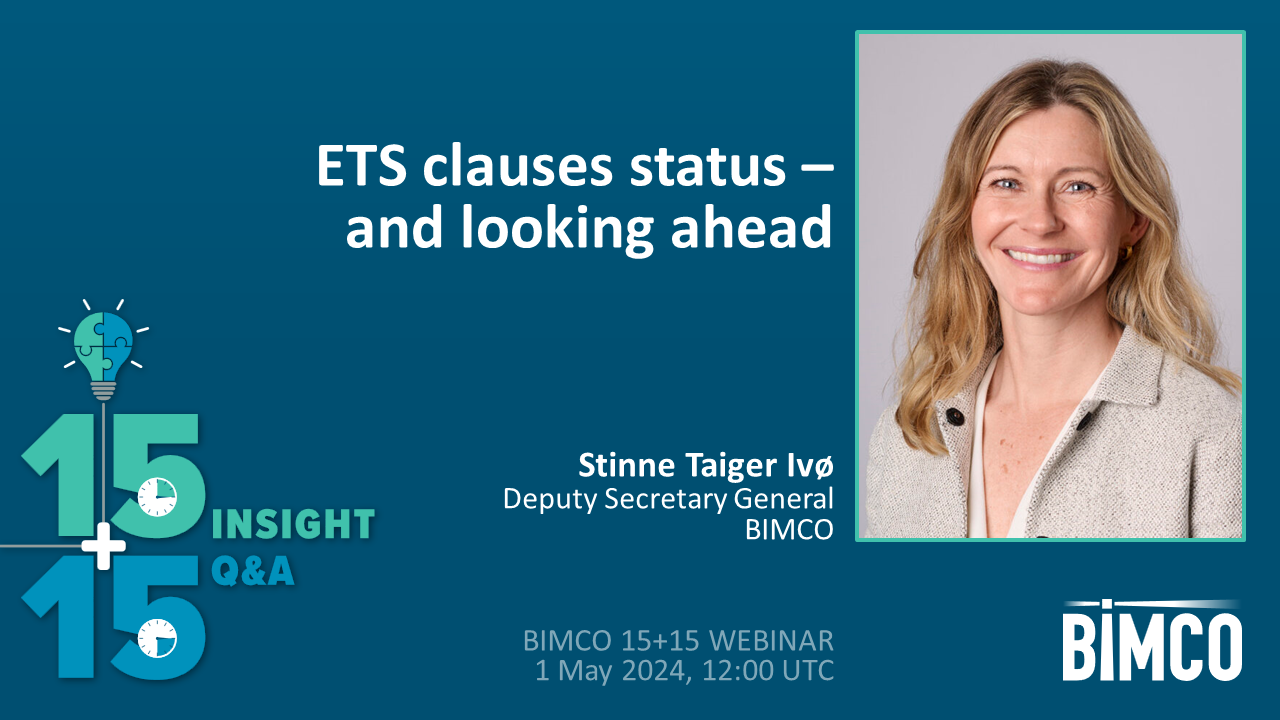SALEFORM 1993
Overview
The latest edition of this contract is SALEFORM 2012.
SALEFORM 1993
Supporting documents
-
0.3 MB
Sample copy of SALEFORM 1993
Download now
Explanatory notes
- Clause 3 - Payment
- Clause 4 - Inspections
- Clause 5 - Notices, time and place of delivery
- Clause 6 - a) Drydocking b) Divers inspection c) Drydocking provisions
- Clause 7 - Spares/bunkers etc.
- Clause 8 - Documentation
- Clause 11 - Condition on delivery
- Clause 13 - Buyer’s default
- Clause 14 - Seller’s default
- Clause 15 - Buyers’ representatives
- Clause 16 - Arbitration
The notes which follow are intended to highlight and clarify the more significant changes introduced in Saleform 1993.
The preamble now states that the Sellers and Buyers have agreed to sell and buy respectively.
A Definitions clause has now been introduced as part of the preamble.
Clause 3 - Payment
The amendments in every respect physically ready for delivery and Notice of Readiness has been given in accordance with Clause 5 are directed at making it clear beyond doubt that the Sellers are not entitled to give notice of delivery before the Vessel is in every respect physically ready for delivery. These amendments were prompted by the English High Court judgment in the “Aktion” which has been a source of some controversy in the market.
Clause 4 - Inspection
The Committee has chosen to provide for two alternatives, either a) outright sale after the Vessel and her class records have been inspected and accepted, or b) an inspection clause similar to that in Saleform 1987 except that “afloat” has been deleted to take account of possible inspection of the Vessel in drydock.
Clause 5 - Notices, time and place of delivery
a) First a specific provision has been introduced for notices of the estimated time of arrival at the intended, place of dry-docking/underwater inspection/delivery. Secondly the new wording placing emph-asis on contractual readiness has been carried over from Clause 3, again with the “Aktion” in mind.
b) The express requirement of safety of the place of delivery is new.
c) The prescribed mechanism by which Sellers can request extension of the cancelling date is new although provisions of this type can be found in the cancelling clauses of certain voyage charter parties. It is certainly not the intention of this provision to enable Sellers to seek to extend time for illegitimate reasons. The underlying requirement of due diligence and the express right conferred on the Buyers to claim damages should guard against this.
d) The MoA now refers also to compromised total loss.
Clause 6 - a) Drydocking b) Divers inspection c) Drydocking provisions
6 a) and b) are alternatives. One is to be deleted from the outset.
It was previously very common for a “diver clause” to be incorporated as an additional clause in the MoA. Clause 6 would then be deleted although the “diver clause” would expressly relate back to the drydocking provisions contained in Clause 6! Insofar as those provisions had by now formally been deleted the Committee was advised that this gave rise to a legal conundrum. Furthermore by bringing a “diver clause” into the main body of the MoA the Committee felt that it would be easier to spell out as clearly as possible the division of expenses in respect of both drydocking and diving operations and accompanying surveys.
As to the content of the clauses, having discussed the matter in some depth with BV, DNV and Lloyds, the Committee has decided to introduce several alterations. When the Vessel has been put in drydock the extent of the inspection by the classification surveyor is intended to follow the normal procedures of the classification society. The classification societies have different inspection procedures, however, thus whereas both Lloyds and DNV manuals prescribe inspection from the deepest load line, BV provide for the whole of the outer shell to be inspected. The Committee thought it logical to adjust the description of the area to be inspected to below the deepest instead of “Summer Load Line”.
The classification societies regard bottom inspection and tailshaft system inspection/survey as two independent and separate surveys. It is the intention that the bottom inspection will be performed in accordance with class rules. However, if the tailshaft system is required to be surveyed by the classification surveyor, it is he who will decide upon the extent of that survey. He may, for example, require the simplex box and sealing rings to be checked in the case of oil leakage and not necessarily ask for the tail end shaft to be drawn. His findings are to take into account the current stage of the Vessel’s survey cycle.
In Clause 6 b) provision has been inserted to cover the situation as to time where, after an underwater inspection, class subsequently requires the Vessel to be put in drydock and no suitable drydocking facilities are available at the port of delivery. In such event the cancelling date may be extended by a maximum of 14 running days. Place of delivery after drydocking is intended to be within the range in Clause 5 b). The Committee felt that it was desirable to prescribe a maximum period for extension of the cancelling date.
This should be kept well in mind when negotiating the date of cancelling.
Some classification societies now use the term “condition” whereas BV, for example, still use “recommendation” hence the reference to “condition/recommendation” in this Clause and Clause 11.
New provisions which have been included in Clause 6 c)(v) are the Buyers’ right to have the Vessel’s underwater parts cleaned and painted, and Sellers’ right to tender Notice of Readiness while the Vessel is in drydock in the event that the Buyers’ work has not been completed by the time the Sellers have completed their work.
Clause 7 - Spares/bunkers etc.
Stores and provisions are now to be included in the sale without any extra payment in accordance with normal practice.
There is also now a provision for extra payment of unused lubricating oils in storage tanks and sealed drums.
Clause 8 - Documentation
The provision for place of closing to be inserted is entirely new.
The documents listed as a) - e) reflect a minimum basic level of Sellers’ obligations. With reference to item f) the Buyers may request additional documents required by the competent authorities for registration purposes but the request is subject to the provisos of reasonableness and time.
Clause 11 - Condition on delivery
One of the reasons for the need to revise Saleform 1987 was the market’s concern in relation to the changed provision contained in the second paragraph of Clause 11. The intention behind the change in 1983/87 was to make redundant the “home made” additional “clause 16”, i.e.- the provision setting out the exceptions from the basic “as is” principle. Unfortunately, the revised wording of Clause 11 gave rise to new and unforeseen problems, and the fact that the majority of contracts contained additional clauses maintaining the “free of average damage” concept, only added to the confusion.
While some uncertainties may now have been resolved (see for example the “Niobe” in the Court of Appeal) the Committee having considered in particular the comments from the hearing round has recommended that the new form incorporates the commonly used phrase free of average damage affecting the Vessel’s class coupled with the obligation to deliver the vessel with her class maintained without condition/recommendation. Finally, there is now an express provision dealing with certificates.
Clause 13 - Buyer’s default
In the event of a default it is normal that any claim will include interest. It was plainly no longer appropriate to provide for a specific rate of interest however and the reference to 12% has therefore been deleted.
Clause 14 - Seller’s default
Saleform 1987 required the Sellers to actually complete delivery by the cancelling date. The Committee felt that it would be preferable for the Buyers’ option of cancellation to arise only if no valid Notice of Readiness were given by the Sellers or if they failed to be ready to validly complete a legal transfer by the cancelling date.
It was recognised, however, that this could end in an undesired result if the Vessel sustained damage after the giving of a valid Notice of Readiness and prior to delivery. The Committee has therefore introduced a provision whereby the Buyers will still have the right to cancel in such a case if the damage is not rectified by the cancelling date.
So far as the Sellers’ “paperwork” is concerned, provided that a valid Notice of Readiness has been given by the cancelling date, the Sellers have up to three banking days after they have tendered Notice of Readiness to arrange for proper documentation failing which the Buyers are entitled to cancel.
As in Saleform 1987 the Buyers retain their right to claim damages for any delays by the Sellers provided that the delay is due to the proven negligence of the Sellers.
Clause 15 - Buyers’ representatives
The Committee has adopted the frequently used extra clause covering Buyer’s right to place their representatives onboard the Vessel after the MoA has been signed and the deposit lodged.
Clause 16 - Arbitration
There are now three alternatives:
a) arbitration London,
b) arbitration New York, and,
c) arbitration elsewhere as agreed.
Related Help & Advice
Create or edit a contract
The one-stop digital shop for all the standard maritime contracts and clauses you’ll ever need.
Latest Related News
-
BIMCO publishes ship financing forms to ensure uninterrupted use of ships
BIMCO has published two standard Quiet Enjoyment Letters (QELs), the first standard form QELs available to the industry, to offer a tool that can ensure the charterers’ uninterrupted use of a ship if the owner defaults under the financing facility.
-
BIMCO starts work on contract for growing wind turbine market
BIMCO has established a subcommittee to work on a global standard contract for the transport and installation of offshore wind turbines. The project has been launched to support the offshore wind industry as the global demand for more renewable sources of energy increases.
-
BIMCO SmartCon information and available contracts
There is a new version of BIMCO SmartCon and it combines the fast, simple and easy approach from the online version, together with the track changes and comments from Word. The editor is online and you don't need to install anything, the only requirement is that you have the latest version of a modern browser like Google Chrome and Microsoft Edge.
-
SmartCon terms of use
Version 6.0, Date: 1 November 2023.
ELSEWHERE ON BIMCO
Holiday calendar
BIMCO's Holiday Calendar covers general holidays in over 150 countries, plus local holidays and working hours in more than 680 ports around the world.
Taxes, tariffs & charges
Access information on national, regional or port tariffs, taxes and charges.
Learn about your cargo
For general guidance and information on cargo-related queries.





